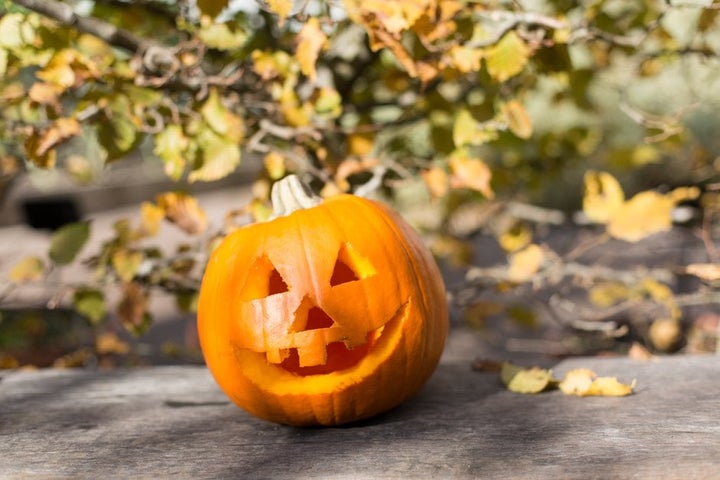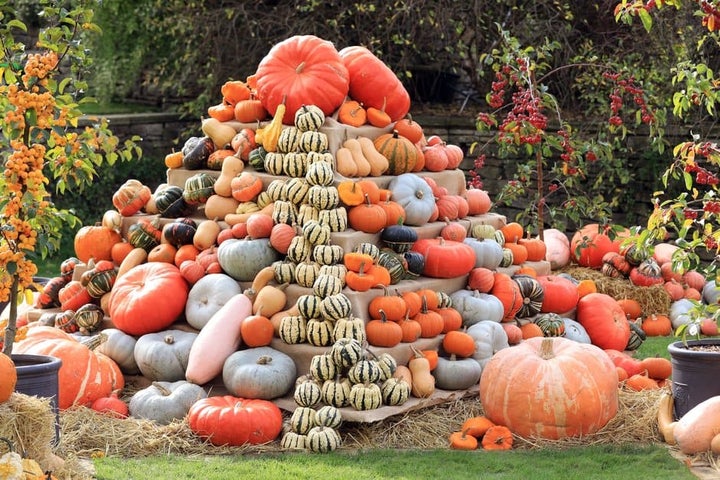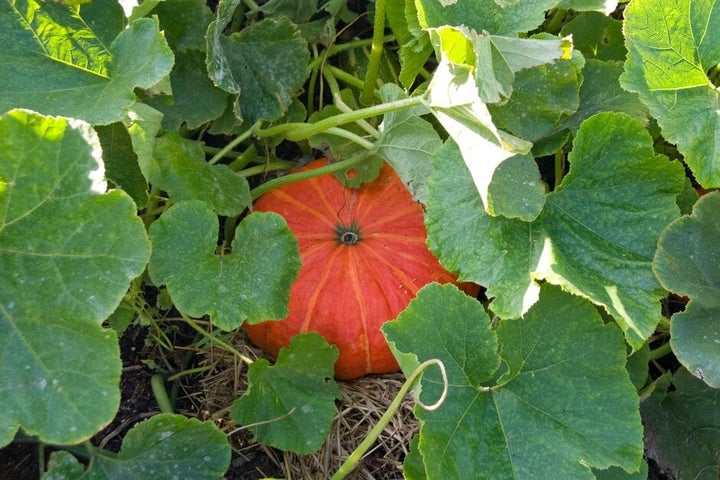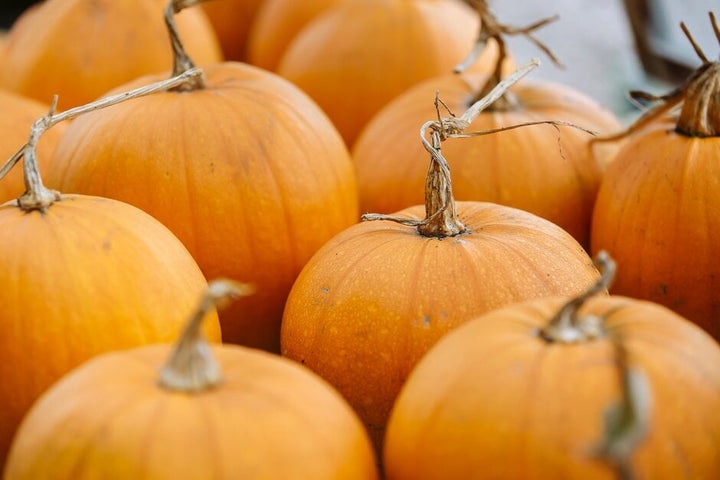Getting Started
Pumpkins are easy and fun to grow – just give them a warm sunny site, plenty of water, and shelter from cold winds. By autumn, you’ll have vibrant pumpkins to carve into Halloween decorations – a great activity to do with kids – or a crop to store for use in winter. Pumpkins are a type of winter squash, traditionally with large, rounded, orange fruits.

Pumpkins are closely related to squashes and courgettes, which are all known botanically as cucurbits – most are varieties of Cucurbita pepo or Cucurbita maxima, with giant pumpkins in particular usually bred from the latter species. They are tender plants, usually grown from seed sown indoors in spring.
Pumpkins need a long, hot growing season, as the fruits are usually grown to maturity and must ripen fully in order to store well for use in winter. Most pumpkin varieties form large sprawling plants that require plenty of space, although more compact bush varieties, usually with smaller fruits, are also available.
Month by Month
Sow
Plant Out
Harvest
Choosing What To Grow

There are many varieties of traditional orange pumpkins, with various sizes of fruit from cricket ball up to beach ball size, and potentially larger. So choose a variety to suit your needs: small to medium fruits are generally more convenient for eating, the larger ones are great for carving into impressive Halloween lanterns, and the giant ones are ideal for entering into shows and competitions.
Some varieties are vigorous trailing plants that spread for several metres or can be grown up supports. There are also bush types, which stay comparatively compact, although still take up at least one square metre. Smaller varieties can potentially be grown in large containers, but most fare best in the ground. So choose varieties that suit the amount of growing space you have available. Pumpkins of various kinds are usually grown in the veg areas of RHS gardens, so do visit to compare varieties and pick up growing tips. For more on choosing pumpkin varieties, see our guide below.
What and where to buy
You’ll find many pumpkin varieties as seed in garden centres and from online retailers. Young plants may also be available in spring and early summer – ideal if you only want one or two plants, or don’t have space indoors to sow them.
Recommended Varieties

'Hundredweight'
As the name suggests, can produce huge fruits in good growing conditions, especially if restricted to one per plant.

'Charmant'
Bright orange fruits, 6–8kg, ideal for Halloween carving. Compact plants with resistance to powdery mildew.
Preparing The Ground

Choose a warm, sunny growing site, with shelter from cold winds and soil that is fertile and moisture retentive but not . Pumpkins generally grow less well in cooler sites. They need lots of space – even the more compact bush varieties can easily reach 90cm (3ft) across.
It’s worth taking the time to prepare the ground well, ahead of sowing or planting outdoors, to ensure your pumpkins thrive. Make a hole about 30cm (1ft) wide and deep, then fill with a mix of soil and organic matter, such as home-made compost. Alternatively, if you're practicing no-dig, the surface and sow or plant directly into the mulch. If you’re aiming to grow giant pumpkins, you could apply an organic-based, general-purpose fertiliser. Space the individual sowing/planting sites at least 90cm (3ft) apart for bush plants and 1.5m (5ft) for trailing plants.
You can also plant compact varieties in growing bags or large containers filled with peat-free multi-purpose or .
Sowing
Pumpkins are best sown indoors in mid-spring, but can also be sown a month or so later outdoors. Indoor sowing offers more reliable results and gives plants a head start and a longer growing season. This is especially useful in colder areas. However, you do need somewhere warm and bright to keep the plants for about six weeks, until they can be moved outside.
Sowing indoors
Sow pumpkin seeds from mid- to late April, into 7.5cm (3in) pots or modular trays filled with peat-free multi-purpose . Sow the flat seeds on their side, 1cm (½in) deep, inserting only one into each pot/module to ensure minimal root disturbance when transplanting. Keep the pots at 18–21°C (65–70°F) in a or place them on a warm, bright windowsill and cover with a clear polythene bag to hold in moisture. Remove once the seeds germinate. For more sowing details, see our guides below.
Water pumpkin regularly, keep them in bright light and repot into slightly larger pots once the roots fill their current pot/module. Plant them out after the last frost – see Planting, below.

Sowing outdoors
You can sow seeds outdoors in late May or early June, after the last frost. Prepare the ground as detailed above. If possible, warm the soil for a couple of weeks ahead of sowing with cloches or plastic-free fleece. Then sow two or three seeds into each prepared site, 2.5cm (1in) deep, and protect with cloches or plastic-free . If more than one seedling germinates in each growing site, remove the weaker one(s) to leave just the strongest.
Planting
You can plant indoor-sown or newly bought plants outside after the last frost. But first, harden them off to acclimatise them to outdoor conditions. Plant the young squash plants into prepared ground (see above), taking care not to disturb the roots. Firm them in gently and water well. Space bush varieties 90cm (3ft) apart and trailing varieties 1.5m (5ft) apart. Protect from slugs and snails, especially in damp weather.
You can also plant very compact bush varieties in growing bags or large containers in a sunny, open spot. Plant one or two per growing bag or one in a container at least 45cm (18in) wide, filled with peat-free multi-purpose or . Make sure there is plenty of space around the container to ensure good air circulation and allow plants to spread. Overcrowded conditions can encourage fungal diseases.
Plant Care
Watering
Pumpkins need plenty of water, especially when fruiting. To make watering easier, sink a 15cm (6in) plant pot into the ground alongside each plant, then pour the water into it. This ensures the water goes down to the roots. Insufficient water can hinder fruiting and encourage powdery mildew. It’s also a good idea to insert a short beside each plant, so you can tell where the centre is after it has grown lots of leaves and long shoots. Use rainwater from a butt whenever possible, and preferably water early in the morning or in the evening on hot days, to minimise evaporation. For more water-efficient advice, see our guides below.
Mulching
After planting, cover the soil surface with a thick layer of , such as home-made garden compost, to help hold in moisture and reduce the need for watering. Leave a gap around the base of the plant stem though, to keep dampness away, which could lead to rotting.
Feeding
Most pumpkins shouldn’t need feeding, unless you want particularly large (or giant) fruits or the plants are growing in containers. In which case, start feeding once the fruits start to swell, applying an organic-based, high potassium liquid fertiliser every 10 to 14 days.
Looking after fruits
Place a tile, brick or piece of wood under developing fruits to keep them off damp soil, which could cause rotting. Also make sure they’re exposed to full sun, to aid ripening – remove a few leaves if necessary – as pumpkins must be fully ripened to store well.
Growing bigger pumpkins
If you want to grow large fruits, then limit the number to just two or three per plant, and for giant pumpkins leave just one, removing any further flowers or fruit that start to form. All the plant’s energy will then be directed into swelling its remaining fruit.
Pruning And Training
If you have plenty of space, pumpkin plants can be left to sprawl over the ground, but if you need to limit their spread, you can train the stems around in a large circle, inserting short canes to hold them in place. You can also simply cut off any stems that stray beyond their bounds.
Trailing types can also be trained up sturdy supports, such as an arch, large wigwam or strong trellis, particularly those with smaller fruits. Just make sure the supports are big and robust enough to carry these vigorous plants and their fruits. You may need to use netting to support the fruits individually. Larger-fruited varieties are best grown flat on the ground.
Harvesting
Pumpkins can be used straight away or stored for use in winter. Let the pumpkins mature and colour up on the plant before harvesting in autumn. Keep them on the plant for as long as possible, but harvest before the first frost, or protect the fruits using straw, or cardboard, as frosted pumpkins can’t be stored.
Cut the pumpkins from the plant with at least 10cm (4in) of stem still attached. If you cut too close to the fruit, it leaves a soft area on the fruit that is prone to rotting.
Prepare pumpkins for storing by laying them out in the sun for a week to 10 days, either outdoors or in a greenhouse or coldframe, to harden (or cure) the skins. This helps to ensure they keep well.

Storing
Store your fully ripened pumpkins in a well-ventilated place at 10–15°C (50–60°F), making sure the fruits don’t touch. Depending on the variety, pumpkins should keep for at least three months, and up to six in ideal conditions. Check them regularly for signs of deterioration or rot.
Problem Solving
Pumpkins are tender, so must be protected from frost and cold. They can also be affected by several diseases, and young plants and flowers may be damaged by slugs and snails. See Common problems below, to find out how to tackle these issues.
Common Problems

Courgette, marrow, pumpkin and squash problems
Courgettes, marrows, pumpkins, squashes and other members of the cucurbit family are fun to grow. It can be worrying, then, when problems strike. Know...

Grey mould
Grey mould, caused by the fungus Botrytis cinerea, is a very common disease, causing a soft decay of plant tissues accompanied by a growth of fuzzy gr...

Slugs and snails
Slugs and snails are common garden animals, and they are well suited to the damp, mild climate of the UK. A few species feed on garden plants, but mos...





